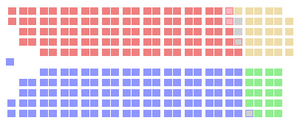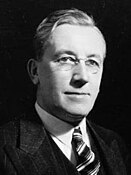
Back الانتخابات الفيدرالية الكندية 1957 Arabic Kanadische Unterhauswahl 1957 German Elecciones federales de Canadá de 1957 Spanish Élections fédérales canadiennes de 1957 French Zaben tarayya na Kanada na 1957 Hausa Elezioni federali in Canada del 1957 Italian Канадски федерални избори во 1957 година Macedonian Pilihan raya persekutuan Kanada 1957 Malay 1957 ਕੈਨੇਡੀਅਨ ਸੰਘੀ ਚੋਣਾਂ Punjabi Eleição federal canadense de 1957 Portuguese
| |||||||||||||||||||||||||||||||||||||||||||||||||||||||||||||||||||||||||||||
265 seats in the House of Commons 133 seats needed for a majority | |||||||||||||||||||||||||||||||||||||||||||||||||||||||||||||||||||||||||||||
|---|---|---|---|---|---|---|---|---|---|---|---|---|---|---|---|---|---|---|---|---|---|---|---|---|---|---|---|---|---|---|---|---|---|---|---|---|---|---|---|---|---|---|---|---|---|---|---|---|---|---|---|---|---|---|---|---|---|---|---|---|---|---|---|---|---|---|---|---|---|---|---|---|---|---|---|---|---|
| Turnout | 74.1%[1] ( | ||||||||||||||||||||||||||||||||||||||||||||||||||||||||||||||||||||||||||||
| |||||||||||||||||||||||||||||||||||||||||||||||||||||||||||||||||||||||||||||
 | |||||||||||||||||||||||||||||||||||||||||||||||||||||||||||||||||||||||||||||
 The Canadian parliament after the 1957 election | |||||||||||||||||||||||||||||||||||||||||||||||||||||||||||||||||||||||||||||
| |||||||||||||||||||||||||||||||||||||||||||||||||||||||||||||||||||||||||||||
The 1957 Canadian federal election was held June 10, 1957, to select the 265 members of the House of Commons of Canada of the 23rd Parliament of Canada. In one of the greatest upsets in Canadian political history, the Progressive Conservative Party (also known as "PCs" or "Tories"), led by John Diefenbaker, brought an end to 22 years of Liberal rule, as the Tories were able to form a minority government despite losing the popular vote to the Liberals.
The Liberal Party had governed Canada since 1935, winning five consecutive elections. Under Prime Ministers William Lyon Mackenzie King and Louis St. Laurent, the government gradually built a welfare state. During the Liberals' fifth term in office, the opposition parties depicted them as arrogant and unresponsive to Canadians' needs. Controversial events, such as the 1956 "Pipeline Debate" over the construction of the Trans-Canada Pipeline, had hurt the government. St. Laurent, nicknamed "Uncle Louis", remained popular, but exercised little supervision over his cabinet ministers.
In 1956, Tory leader George A. Drew unexpectedly resigned due to ill health. In his place, the PC party elected the fiery and charismatic Diefenbaker. The Tories ran a campaign centred on their new leader, who attracted large crowds to rallies and made a strong impression on television. The Liberals ran a lacklustre campaign, and St. Laurent made few television appearances. Uncomfortable with the medium, the Prime Minister read his speeches from a script and refused to wear makeup.
Abandoning their usual strategy of trying to make major inroads in Liberal-dominated Quebec, the Tories focused on winning seats in the other provinces. They were successful; though they gained few seats in Quebec, they won 112 seats overall to the Liberals' 105. With the remaining seats won by other parties, the PC party only had a plurality in the House of Commons, but the margin was sufficient to make John Diefenbaker Canada's first Tory Prime Minister since R. B. Bennett in 1935.
- ^ "Voter Turnout at Federal Elections and Referendums". Elections Canada. Retrieved March 10, 2019.



